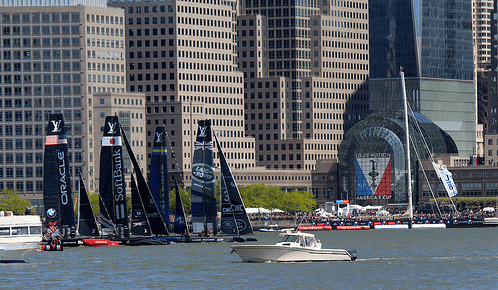Source: Stevens
When the America’s Cup racing series returned to its Hudson River roots May 6-8, Stevens and CMCC Foundation ingenuity were on display before a global audience.
Both the top finishers in the weekend regatta — a preliminary event leading up to the 35th America’s Cup in 2017 in Bermuda, condensed to one day of racing by weather conditions — shared a common thread: each team has drawn on the expertise of a Stevens faculty expert during the design of its racing yachts.
And all six competing teams, including entrants from France, Sweden and Japan, depended upon daily current, flow and wind forecasts generated by Stevens in collaboration with a smartphone app created by the CMCC Foundation.
“The opportunity to forecast for the America’s Cup racing is a special recognition of the quality research at Stevens,” said Stevens professor and Davidson Laboratory director Alan Blumberg, who watched the race from close up in New York City’s Battery Park.
Watch the video
:
Leveraging history and technology
Stevens’ founding family created the America’s Cup race in 1851, when university founder Edwin A. Stevens and his brother John Cox Stevens sailed to England and challenged the royal navy to a winner-take-all race around the Isle of Wight. The Stevens’ yacht America triumphed, and the cup they brought back to U.S. soil became international sporting’s oldest trophy and the ultimate sailing prize.
In addition to its historical link to the May race on the Hudson, Stevens also provided key logistical support, including up-to-the-minute forecasts of the tricky conditions on the river throughout the weekend.
The event took place along a short stretch of river ranging roughly from Wall Street north to the Jersey City waterfront. Proprietary Davidson forecast engines generated predictions, aided by a dedicated Stevens supercomputer. Blumberg briefed the racing commission pre-event on race day with the specialized forecast.
Davidson researcher Nickitas Georgas also coordinated updates four times daily to the CMCC team, who updated NY SeaConditions, the app it had created for Stevens and the event. Racing teams checked the app regularly before and during the race.
“Feedback from the teams was excellent,” said Blumberg, noting that Stevens’ forecasts are so accurate and respected that the National Weather Service now points all visitors to its website for New York Harbor forecasts directly to Stevens’ NYHOPS website.
Designs on victory
Stevens’ influence was also felt in the catamarans designs that placed first and second in the event, Team Oracle USA and Emirates Team New Zealand.
Emirates Team New Zealand, winner of the Hudson River event, had previously utilized Stevens ocean engineering professor Len Imas’ research and insights to propel its own 2013 powerful challenge. Imas, a world-renowned expert in computational hydrodynamics, served as a hydrodynamicist and modeling engineer for ETNZ’s design group, creating and performing computer simulations of various flow and sailing conditions for what would be the runner-up yacht in 2013.
During the current Cup series, Team Oracle USA’s yacht design now also relies partly on Imas’ work. The Team Oracle yacht finished second in the Hudson event.
“Len’s work has been fantastic, and has helped shaped the field,” noted Blumberg. “We’re very fortunate to have a leading international researcher in this discipline here at Stevens.”
For more on Stevens marine modeling, forecasting and craft design, visit stevens.edu/Davidson and CMCC Ocean-Lab website.




